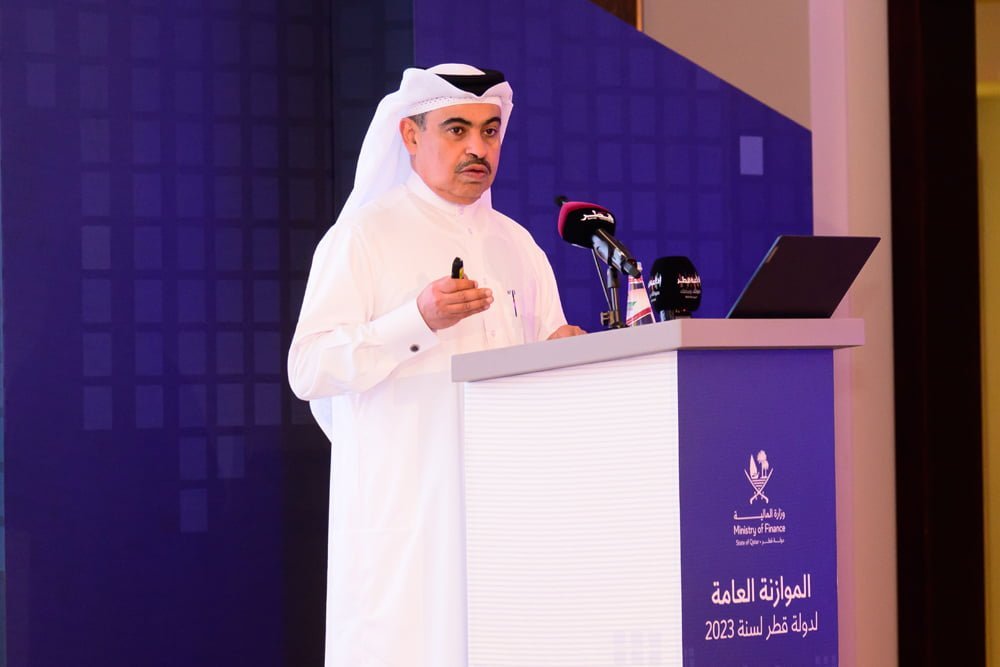Minister of Finance H E Ali bin Ahmed Al Kuwari presents the budget 2023 at the Ministry of Finance, yesterday.
Doha: The 2023 budget estimates total revenues in 2023 at QR228bn ($65bn), an increase of 16.3 percent compared to the 2022 budget. Minister of Finance H E Ali bin Ahmed Al Kuwari presenting the general budget 2023 at the Ministry of Finance yesterday attributed the increase in public revenues mainly to the adoption of an average oil price of $65 per barrel for the 2023 financial year in place of the $55 per barrel price in the 2022 budget.
Minister Kuwari chaired a press conference announcing Qatar’s general budget for the 2023 fiscal year, which sets spending at QR199bn ($54.6bn), a 2.6 percent decline from the general budget for 2022.
The general budget was based on an oil price of $65 per barrel, a conservative figure adopted by the Ministry of Finance as part of its strategy to allocate financial resources towards existing commitments expected during the year and to fund national development strategy programs and projects.
This increase is a result of the remarkable recovery in global energy prices during the current year, in addition to energy prices, which International Financial Institutions (!Fis) estimate will continue to rise in the medium term. Estimates of total oil and gas revenues for the next year are estimated at QR186bn compared to QR154bn for 2022, which represents an increase of 20.8 percent.
The Minister of Finance revealed that the increase in estimated revenues for 2023, in addition to the limited decline in expenditures, both have shifted the budget balance from a deficit to a surplus estimated at QR29bn. The Minister added that the Ministry of Finance will work to enhance the State’s financial reserves by transferring the surplus to the general reserve account in accordance with the provisions of the State Financial System, no. 2 of 2015.
The Minister also pointed out that non-oil revenues for 2023 remain stable compared to the 2022 budget, estimated at QR42bn. The Minister said that the Ministry of Finance is currently working in coordination with the relevant authorities to follow up on the implementation of some measures that would increase non-oil revenues during 2023.
Some of these measures include expanding the list of goods covered by the excise tax and reviewing some government fees. Estimates of revenues resulting from the possible implementation of these measures during 2023 were not added to the budget based in line with the Ministry’s conservative approach to public revenues estimates.
He stated that spending on salaries and wages will increase in 2023 while spending on major projects will decline. Spending on salaries and wages will increase by QR4bn (6.3 percent) compared to 2022, which is estimated at QR62.5bn.
This increase, His Excellency added, is caused by higher rates of public sector employment for 2023, prompted by the new government structure approved by His Highness the Amir towards the end of 2021. Spending will also cover grants, allowances and retirement based on the recent pension plan, which sets a minimum age and period of service.
Allocations for operating expenses will decline, primarily due to the high costs of sustaining public utilities and infrastructure. This will have an important impact on the post-World Cup phase, in light of the integrated infrastructure that is fundamental to the development and prosperity of the local economy.
The allocations for major projects in 2023 will decline by 13.6 percent compared to 2022, estimated at QR63.9bn, with the completion of several
infrastructure and strategic projects, the latest of which is the expansion of Hamad International Airport prior to the start of the FIFA World Cup Qatar 2022.
The continued high spending on public projects is also attributed to the State’s plans to complete and finalise infrastructure projects, especially those related to existing and new citizens’ lands as well as projects supporting the local economy.
Priority sectors Allocations for the health and education sectors will increase during 2023, in line with the State’s continued focus on these two sectors. This includes, as announced by the Minister of Finance, the development of a number of new schools and the improvement of school facilities, in addition to a number of new and existing hospitals and healthcare centres. Spending on health in the next year’s budget is estimated at QR21.1bn, compared to QR20bn in 2022, which constitutes 11 percent of the total budget. Spending for the education and higher education sector, meanwhile, is estimated at QR18bn, compared to QR17.8bn in the 2022 budget, or 9 percent of the total budget.
On the other hand, spending on the culture and sports sector is estimated at QR9.3bn, compared to QR16.6bn in the 2022 budget, or 5 percent of the total budget. The decline in spending on the culture and sports sector is attributed to finalising all projects tied to the hosting of the FIFA World Cup Qatar 2022 and related expenses. In this context, His Excellency indicated that the assets already developed and currently available still give the State of Qatar an advantage when presented with an opportunity to host other sporting events and would contribute to realising the State’s goal of becoming a global sports hub.
Government debt Public debt decreased from 58 percent in 2021 to about 44.5 percent of GDP, as a result of the State’s commitment to paying due external debt, in addition to the growth in GDP at current prices.
The rise in energy prices and the Qatar’s conservative fiscal policy (spending control and reducing levels of public debt, especially external debt) have improved the State’s credit rating.
His Excellency revealed that the credit rating company known as Moody’s had raised Qatar’s outlook from stable to positive, while Standard & Poor’s had raised the country’s credit rating from (AA-) to (AA), with a stable outlook. The country’s credit rating, His Excellency said, reaffirms financial stability as well as a strong and flexible local economy, both of which attract foreign investments and help reduce the cost of borrowing.

